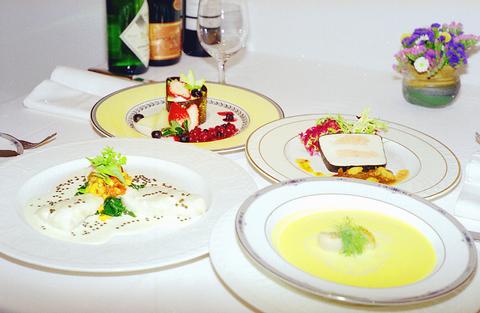Pasadena, a restaurant specializing in French and Mediterranean cuisine, is an unexpected find in the northern purlieus of Kaohsiung City, but one that in the one year it has been running, has established itself as a favorite among both the local and foreign community. Managed by David Sha, Pasadena places particular attention on refined taste, a quality that informs the food, the wines and even the crockery and cutlery used there.
"We enjoy using luxury items," said Sha, who currently has many dishes sporting sevruga and oscieta caviar. The subtle taste is brought out to great advantage with the garoupa served with cream and caviar. While not cheap, there is little doubt that you are getting value for money, and the feeling of luxury is further enhanced by the Wedgewood china and heavy French cutlery.
The best of everything pretty much sums up what Pasadena is all about -- the best, and then a little bit more. "Just take something like beef tenderloin. Everyone does pretty much the same. So we made it a bit more special, adding truffle puree -- and the truffles are imported fresh," Sha said.

PHOTO: IAN BARTHOLOMEW, TAIPEI TIMES
Pasadena's chef Thomas Chien (
Pasadena is a large restaurant, but Sha has allowed for wide areas between the tables to give the atmosphere an expansiveness that would be hard to find in often tightly packed Taipei eateries. "We like to give our guests some sense of privacy as well," Sha said, adding that expansion plans currently include a number of private rooms for publicity-shy celebrities.
With plans to expand with its own patisserie, it is no surprise that both the bread and deserts at Pasadena are also outstanding, offering still unusual types as rolls with squid ink and multi-grain with pumpkin seeds.
A set menu featuring the garoupa with cream and caviar will set you back NT$1,300, but this price includes a selection of four appetizers (including the salmon terrine), a soup, a sherbet to cleanse the palette, the main course, followed by desert and coffee, a set up that encourages leisurely dining, perhaps with the addition of a bottle of wine from the restaurant's wide selection.
For something a little less expensive, Pasadena's afternoon tea, with its bottomless coffee -- good coffee it is, too -- and limitless supply of cakes, is a great way to spend the afternoon for just NT$250. Given the comfortable surroundings and formal yet friendly service, you might even be tempted to stay on for dinner.

On April 26, The Lancet published a letter from two doctors at Taichung-based China Medical University Hospital (CMUH) warning that “Taiwan’s Health Care System is on the Brink of Collapse.” The authors said that “Years of policy inaction and mismanagement of resources have led to the National Health Insurance system operating under unsustainable conditions.” The pushback was immediate. Errors in the paper were quickly identified and publicized, to discredit the authors (the hospital apologized). CNA reported that CMUH said the letter described Taiwan in 2021 as having 62 nurses per 10,000 people, when the correct number was 78 nurses per 10,000

As we live longer, our risk of cognitive impairment is increasing. How can we delay the onset of symptoms? Do we have to give up every indulgence or can small changes make a difference? We asked neurologists for tips on how to keep our brains healthy for life. TAKE CARE OF YOUR HEALTH “All of the sensible things that apply to bodily health apply to brain health,” says Suzanne O’Sullivan, a consultant in neurology at the National Hospital for Neurology and Neurosurgery in London, and the author of The Age of Diagnosis. “When you’re 20, you can get away with absolute

May 5 to May 11 What started out as friction between Taiwanese students at Taichung First High School and a Japanese head cook escalated dramatically over the first two weeks of May 1927. It began on April 30 when the cook’s wife knew that lotus starch used in that night’s dinner had rat feces in it, but failed to inform staff until the meal was already prepared. The students believed that her silence was intentional, and filed a complaint. The school’s Japanese administrators sided with the cook’s family, dismissing the students as troublemakers and clamping down on their freedoms — with

As Donald Trump’s executive order in March led to the shuttering of Voice of America (VOA) — the global broadcaster whose roots date back to the fight against Nazi propaganda — he quickly attracted support from figures not used to aligning themselves with any US administration. Trump had ordered the US Agency for Global Media, the federal agency that funds VOA and other groups promoting independent journalism overseas, to be “eliminated to the maximum extent consistent with applicable law.” The decision suddenly halted programming in 49 languages to more than 425 million people. In Moscow, Margarita Simonyan, the hardline editor-in-chief of the